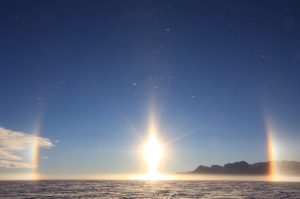Did you know that the Antarctic sun keeps dogs?
Dry, thin, freezing cold air and a sterile immensity of snow makes the Antarctic Plateau hostile to humans. It can also turn it into an atmospheric display of beauty.
 Sundogs of the finest pedigree, as seen over Tønnesenbreen (glacier) in Dronning Maud Land, late in a November evening. Photo: Stein Tronstad / Norwegian Polar Institute
Sundogs of the finest pedigree, as seen over Tønnesenbreen (glacier) in Dronning Maud Land, late in a November evening. Photo: Stein Tronstad / Norwegian Polar Institute
An average summer’s day on the high plateau offers crisp air, temperatures hovering somewhere between minus 20 and minus 30°C, moderate winds and scattered, light clouds. This being the driest continent on Earth, there is but a hint of precipitation, falling from nothing in the shape of very fine ice crystals known as “diamond dust”.
Diamond dust can form when the air is cold enough for all moisture to freeze, often under otherwise clear skies. It happens when slightly warmer air up above mixes with the cold surface air layer, bringing down water vapour that freezes into minute ice crystals in the colder air. What meets the eye is clear air with a sprinkling of bright flashes as the sun is reflected in the ice crystals, looking like the twinkling of a thousand tiny diamonds.
Because these little prisms of ice have regular, hexagonal shapes they refract the light in specific directions, creating a magnificent palette of rainbow-like phenomena that can take many different shapes.
Just before or after sunrise or sunset we can have a light pillar, a vertical column of light growing from the horizon. Then there is the common halo, a ring around the sun (or the moon if the sun is off duty) that can be seen throughout the day.
When the sun gets lower in the sky, the ‘sundogs’ will come out. They are twins, two bright and often rainbow-coloured patches of light on the halo, horizontally to either side of the sun. Sundogs may be seen at other latitudes, formed by ice crystals in very high clouds, but they show their best in Antarctica, when formed by the diamond dust close to the ground. At their most glorious, they may be topped by a ‘circumzenithal arc’, virtually a rainbow on its back, or a smile in the sky.
The Antarctic Plateau itself may seem endless and desolate, but offers ample rewards for the weary eye. Halos, sundogs, tangent arcs, drifting snows, shifting sunlight, passing mists, glittering diamond dust and the glow of high clouds create beauty and variety even where everything is level.